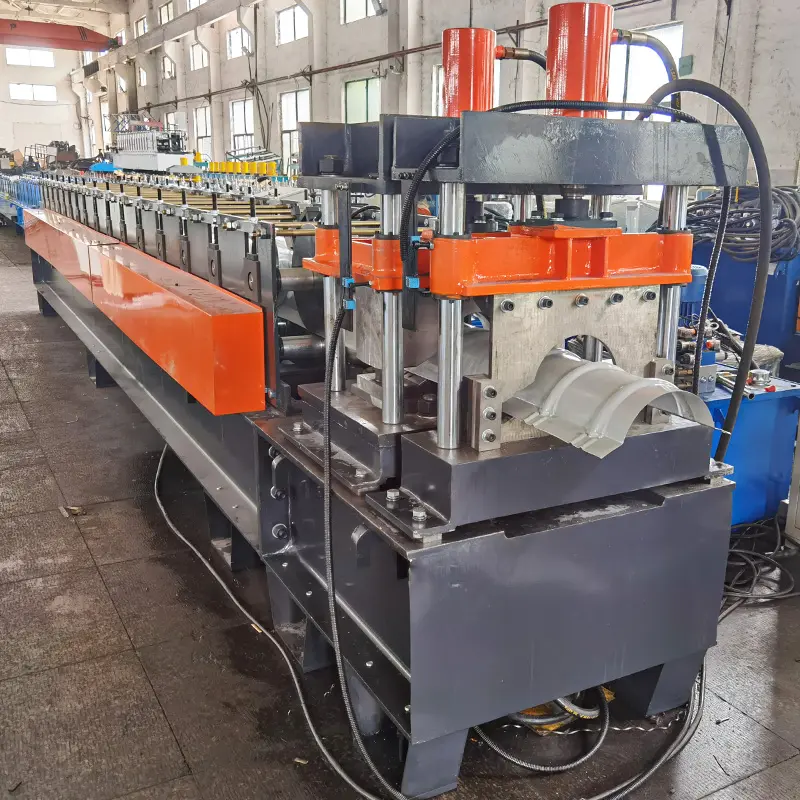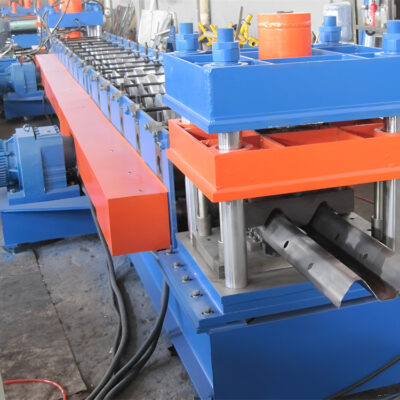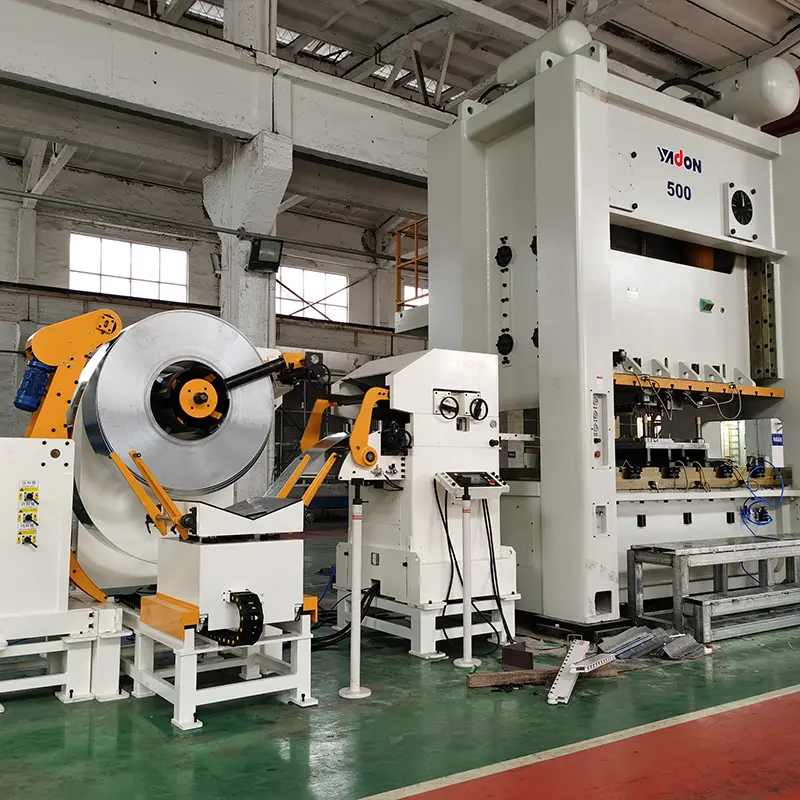Imagine a rainy day. The pitter-patter of raindrops against your roof creates a comforting rhythm. But as the downpour intensifies, concerns about clogged gutters and overflowing basements might start to cloud your mind. Thankfully, gutter forming machines play a crucial role in ensuring efficient rainwater management, protecting your home and property from water damage.
Types of Gutter Forming Machines
Gutter forming machines come in various configurations, each catering to specific needs and applications. Here’s a breakdown of the most common types:
- K-style gutter machines: These machines produce the most popular type of gutter in North America, featuring a distinctive angled profile that resembles the letter “K.” They are available in different sizes to accommodate various roof sizes and rainfall amounts.
- Half-round gutter machines: As the name suggests, these machines form gutters with a semicircular profile. They are often preferred for their aesthetic appeal and are commonly seen in historical districts or on buildings with curved roofs.
- Box gutter machines: These heavy-duty machines create box-shaped gutters, ideal for commercial buildings and industrial applications where they need to handle large volumes of water.
- Custom gutter machines: For unique architectural designs or specific project requirements, custom gutter machines can be used to form gutters in various shapes and sizes.

How to Choose the Right Gutter Forming Machine
Selecting the right gutter forming machine requires careful consideration of several factors:
- Gutter profile: Determine the desired gutter style, be it K-style, half-round, box, or custom.
- Material compatibility: Ensure the machine is compatible with the type of material you intend to use, such as aluminum, steel, or copper.
- Production capacity: Consider the volume of gutters you need to produce and choose a machine with a production speed that meets your requirements.
- Portability: If you need to move the machine frequently between job sites, portability becomes a significant factor.
- Ease of operation: The complexity of the machine’s operation should align with your technical expertise and comfort level.
- Cost: Gutter forming machines range in price from a few thousand dollars to tens of thousands, so set a realistic budget and compare features and functionalities within your price range.
Expert Tip: Consulting with experienced gutter machine manufacturers or distributors can provide valuable insights and recommendations tailored to your specific needs.
The Forming Process of a Gutter Forming Machine
Imagine rain cascading down your roof, overflowing the eaves, and potentially causing damage to your foundation. Thankfully, gutters stand guard, channeling this torrent away from your home. But have you ever wondered how these crucial components are actually made? Buckle up, as we delve into the fascinating process of gutter formation:
1. The Metallic Journey Begins:
The adventure starts with a coil of metal sheet, typically aluminum or steel, acting as the raw material. This coil is loaded onto the machine’s unwinder, akin to a giant spool, ready to be unfurled.
2. Shaping Up:
The metal sheet embarks on a transformative journey. It’s fed through a series of forming rollers, each strategically shaped. These rollers progressively bend and shape the sheet, not unlike a sculptor molding clay, until it achieves the desired gutter profile. Imagine a flat sheet gradually morphing into the familiar U-shaped channel.
3. Sealing the Deal:
With the basic shape established, it’s time to secure the edges. The machine employs a folding mechanism that neatly folds the formed sheet’s edges inwards. This creates a clean and secure seam, ensuring the gutter functions flawlessly and maintains structural integrity.
4. Precise Cuts:
Just like a tailor measuring fabric, the machine employs a cutting mechanism. This ensures each formed gutter section is precisely cut to the desired length. This ensures a perfect fit when installed, preventing any unwanted gaps or overflows.
5. Ready for Action:
The final step involves stacking. The finished gutters, now boasting their precise shape and secure seams, are neatly stacked, ready for easy handling and transportation. They await their final destination – your roof – where they’ll faithfully guard your home against the elements.
-
 Highway Guardrail End Terminal Forming Machine
Highway Guardrail End Terminal Forming Machine -
 Highway U/C Post Roll Forming Machine
Highway U/C Post Roll Forming Machine -
 2 Waves Highway Guardrail Roll Forming Machine
2 Waves Highway Guardrail Roll Forming Machine -
 3 Waves Highway Guardrail Roll Forming Machine
3 Waves Highway Guardrail Roll Forming Machine -
 वाइनयार्ड पोस्ट रोल बनाने की मशीन
वाइनयार्ड पोस्ट रोल बनाने की मशीन -
 ऑटो आकार बदलने योग्य सिग्मा शहतीर रोल बनाने की मशीन
ऑटो आकार बदलने योग्य सिग्मा शहतीर रोल बनाने की मशीन -
 विद्युत कैबिनेट फ्रेम रोल बनाने की मशीन
विद्युत कैबिनेट फ्रेम रोल बनाने की मशीन -
 दीन रेल रोल बनाने की मशीन
दीन रेल रोल बनाने की मशीन -
 दो लहरें राजमार्ग रेलिंग मशीन
दो लहरें राजमार्ग रेलिंग मशीन
Advantages of Using a Gutter Forming Machine
1. Unleashing Efficiency:
Imagine eliminating the wait for pre-fabricated gutters and the hassle of delivery. Gutter forming machines bring the production process directly to your site. This translates to significant time savings, allowing you to complete installations faster and streamline your workflow. No more waiting for deliveries or dealing with delays due to unforeseen circumstances.
2. Embracing Sustainability through Reduced Waste:
Pre-fabricated gutters often require cutting and adjustments to fit specific needs, leading to significant material waste. Gutter forming machines break free from this limitation. They function like a custom tailor for gutters, precisely cutting the material to the exact length needed, minimizing leftover scraps. This not only reduces material costs but also promotes a more sustainable approach to construction.
3. Customization: Tailoring the Perfect Fit for Every Project
Gone are the days of being limited to a few standard sizes and styles. Gutter forming machines empower you to create gutters that perfectly match your project’s unique requirements. Whether you need specific sizes to accommodate different roof pitches or desire a particular style to complement the building’s aesthetics, these machines offer the flexibility to bring your vision to life.
4. Built to Last: Durability that Stands the Test of Time
Gutter forming machines are constructed with robust and long-lasting materials. This ensures they can withstand the demands of continuous use on various job sites. Their reliable operation translates to fewer maintenance concerns and a longer lifespan, making them a worthwhile investment for any contractor or construction company.
Disadvantages of Using a Gutter Forming Machine
While gutter forming machines offer the allure of on-demand gutter production, there are several hidden costs to consider before taking the plunge.
Financial Hurdle: The initial investment can be significant, especially for top-of-the-line models with advanced features. This hefty upfront cost can be a burden for smaller contractors or DIY enthusiasts seeking a one-time project solution. Renting a machine might be a more cost-effective option in such cases.
Knowledge is Power (and Safety): Operating a gutter forming machine isn’t as simple as pushing a button. Learning to set it up, operate it effectively, and perform proper maintenance requires a technical understanding of the machinery and its functionalities. Improper use can lead to wasted materials, subpar gutter quality, and even safety hazards due to malfunctioning equipment. Investing in proper training and familiarizing yourself with the machine’s manual is crucial before attempting to use it.
Space Constraint: These machines aren’t exactly compact. They can occupy a significant amount of floor space, which can be a major drawback for individuals with limited storage facilities. Consider your available storage space before making the purchase, as failing to properly store the machine can expose it to damage and reduce its lifespan.

सामान्य प्रश्न
Q: What is the typical lifespan of a gutter forming machine?
A: With proper maintenance, a well-built gutter forming machine can last for decades.
Q: Can I rent a gutter forming machine instead of buying one?
A: Some companies offer gutter forming machine rentals, which can be a cost-effective option for occasional use.
Q: What safety precautions should I take when operating a gutter forming machine?
A: Always wear appropriate safety gear, such as gloves, safety glasses, and hearing protection, when operating the machine. It’s crucial to follow the manufacturer’s instructions and safety guidelines carefully.
